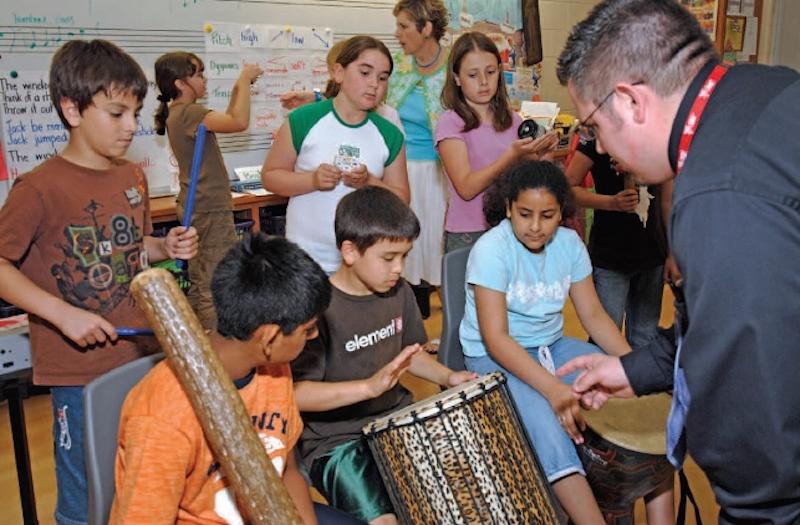
Music and Make Believe: The Key Role of Arts in Literacy Instruction (Professional Services)
“We will never obtain the high results in literacy that we are seeking in Ontario until strong arts programs and teaching are in place in elementary schools.” Bob Barton, a teacher and language consultant for more than 30 years, shared this view at a drama workshop for teachers taking their drama additional qualification course. It is a concern we have heard for many years from other leading educators like David Booth, Kathy Lundy, and Larry Swartz.
Many people still consider the arts a luxury or frill, a source of amusement, or a leisure activity. Some policy makers believe the arts divert attention and resources from other subject areas that prepare students for the competitive workplace and high-paying jobs. Having never experienced a high-quality arts program, they have no point of reference and don’t understand the benefits of strong arts programs for student learning.
Educational research overwhelmingly shows arts education makes kids smarter. By hiring full-time music teachers or setting up fully equipped visual arts rooms, educational leaders are promoting literacy learning. But many do not make the connection. With the rigid and narrow focus on literacy and numeracy that has existed in schools over the past few years, many teachers are left with the misperception that there are only a few strategies for teaching curriculum expectations. Ironically though, the arts are often used to showcase our schools’ major accomplishments. Attend any school open house and you will encounter the arts in the form of choir or band concerts, plays, dance performances, or hallways and classrooms decorated with paintings and artwork.
Having strong arts instruction and experiences in our elementary schools will not only improve literacy scores, it will ultimately resurrect students’ enthusiasm for reading, writing, and literacy activities, which has been so lacking in our schools of late. Interest and engagement are key factors to high academic achievement. Educational expert Alfie Kohn stresses that “where interest appears, achievement usually follows . . . interest drives competence.”1
Every individual has his or her own way of learning and thinking. Because the arts draw on a variety of intelligences, they can help students learn in most subject areas, as well as increase the capacity to think critically, creatively, and imaginatively. Research into brain functioning increasingly supports arts education as a way for students to develop capacities for these higher-level skills. An education enriched by the arts can;
- improve cognition
- further social development and teamwork
- stimulate personal development and self-discipline
- nurture perseverance and hard work
- prepare students to attend to multiple tasks, take risks, and capitalize on their mistakes
- teach the importance of multiple perspectives, personal interpretation, and choice.
Developmental psychologist Howard Gardner suggests that arts-based strategies be used to help students who are having difficulty in particular subject areas.2 For example, if a child is having difficulty grasping a mathematical concept, the teacher could use music to develop the child’s understanding. Eric Jensen, one of the world’s leading interpreters of educational neuroscience, believes that “the arts are not only fundamental to success in our demanding, highly technical, fast-moving world, but they are what make us most human, most complete as people.”3
In support of arts education, ETFO has developed a practical book for Junior grades teachers who are new or inexperienced in arts education. ETFO Arts introduces all the elements of dance, drama, music, and visual arts and shows educators how to use the arts to support literacy and other subjects.
Thanks to funding received from the Ministry of Education to support professional development, a dynamic four-part arts series was offered this year in 10 ETFO locals to show teachers how ETFO Arts can be used in a classroom. Each of those locals identified an arts educator who then received training during the summer with the ETFO Arts writers Bonnie Anthony, Carol MacKenzie, Jane Wamsley, and Jennifer Zeitz.
Teachers who took part said they appreciated the opportunity to enrich their teaching and improve their understanding. “I am impressed that ETFO has realized a much-needed support document for teachers who are not specialists,” wrote one participant in Rainy River. “Now, I have more knowledge about arts subjects.”
Kevin Merkely, a curriculum consultant for the York Region District School Board, highlighted the practical applications of the resource in a recent review published in the Ontario Music Educators’ Association journal, The Recorder:
Although ETFO Arts is targeted for the junior teacher, this resource would be a welcome addition to the collection of any elementary teacher. Many of the activities illustrated in this resource could be easily adapted and modified for the primary and intermediate classroom. The format of the content for all of the arts is consistent and well organized. Any classroom teacher that teaches the arts will find the elements description and the student activities very helpful. Not only would this resource be invaluable to classroom teachers, it would be a great addition to the professional library of elementary music specialists.
To obtain your copy of ETFO Arts, visit the ETFO website, etfo.ca and click on shopETFO.
The Summer Arts Academy for specialist and experienced arts teachers will be offered again this year, as part of ETFO’s 2008 Summer Academy.
Notes
1. Alfie Kohn, The Schools Our Children Deserve, New York: Houghton Mifflin, 1999, p. 128.
2. Howard Gardner, Frames of Mind: The Theory of Multiple Intelligences, New York: Basic Books, 1993.
3. Eric Jensen. Arts with the Brain in Mind, Alexandria, VA: Association for Supervision and Curriculum Development, 2001, p. vii.
